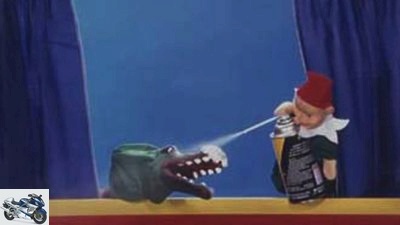Table of contents

fact
counselor
workshop
Basics: chemical helpers
Basics: chemical helpers
Chemistry from a can or tube
Chemistry from cans or tubes is not an unnecessary luxury in the workshop, but a real help with screwing.
12/19/2007
The oil can was enough for our screwing ancestors in almost all situations. However, if they had already had our modern chemistry kit available, the lubricant monoculture would have been over quickly. A selection:
Penetrating oil:
The all-purpose weapon when it comes to lubricating small bearings or preserving. Incorrectly referred to as “contact spray” because it displaces water. However, these sprays cannot clean electrical contacts. Nevertheless: A life without the all-purpose miracle weapons such as “WD-40” or the legendary gun oil “Ballistol”, which deserve the Nobel Prize in Chemistry, is perhaps conceivable these days, but makes little sense. There is no more convenient way to make / hold hand and foot levers, cables and locks. Also helps if chain spray has dirty the rear wheel.
Brake cleaner:
Grease and oil have no place on brake components. With brake cleaner, discs, drums and calipers are clinically clean again. The skin-stressing agent (degreasing effect!) Works completely residue-free.
Sealing paste:
Is used wherever no paper or cork seals are used in the areas to be sealed. Is already used during assembly, but can also be used later as a stopgap against leakages. It’s available in many different “recipes” for a wide variety of uses. Therefore, when buying, it is essential to pay attention to the required heat and gasoline resistance. Well-known brand names are “Dirko”, “Curil” and “Hylomar”.
Screw locking:
If there are no spring washers, lock washers, self-locking nuts or split pins to ensure that components stay in place, liquid screw locking is often used. With the exception of the brake discs, for which “high-strength” screw locking (e.g. “Loctite 2701”) is required, “medium-strength” quality (e.g. “Loctite 243”) is almost always required. Anyone who thinks that they can drive better with “high strength”, even if only “medium strength” is required, is making a major mistake that they will recognize when unscrewing (or trying).
Other aids
Carburetor Cleaner:
Cleans nozzles, mixing tubes and loosens deposits (e.g. in the dismantled float chamber). Also takes care of the plastic parts in the carburetor. Usually leaves a light film of oil and is therefore extremely unsuitable as a replacement for brake cleaners.
Silicone spray / lubricant:
A water-repellent, grease-free lubricant for the care of rubber and plastic parts as well as locks and hinges (e.g. suitcases). Provides excellent service on side cover noses and the associated rubber stoppers. Like creeping oil, it is an essential part of every screwdriver household. Almost always suitable as a no-name product or house brand.
Copper paste:
Almost indispensable when screw connections are very susceptible to corrosion and / or exposed to extreme heat. A tube usually lasts forever, as only the smallest quantities are needed to keep the thread permanently usable.
Breakdown Spray:
The last resort in the event of a puncture far from civilization. A repair kit for tubeless tires is preferable to a puncture spray – if you have the choice and the knowledge of screwdrivers. The failure rate when using breakdown spray is an estimated 50 percent (also due to operating errors), the annoyance rate when changing tires is close to 100, because the stuff makes a huge mess that is difficult to remove. Nevertheless: It’s always better than nothing.
Chain spray:
Better regularly and economically than rarely and too violently – that is the motto of the professional chain sprayer. Further tips are that the inside of the chain is more important than the outside and that it should not be sprayed directly before the ride, but rather a few hours beforehand (so that the propellant and solvents can evaporate).
Universal grease:
Belongs everywhere where nothing turns fast and fat makes more sense (because it is more permanent) than oil. For example on the stand mechanism and the swing arm.
Related articles
-
Artist counselor workshop Basics: Motorcyclist Injuries Basics: Motorcyclist Injuries What can happen We like to suppress it, but riding a motorcycle is…
-
archive counselor workshop First aid basics This is how it works: First aid What if? First aid is a civic duty. Not just ideally, but specifically…
-
Basics: chain, cardan, toothed belt
archive counselor workshop Basics: chain, cardan, toothed belt Basics: chain, cardan, toothed belt Advantages and disadvantages explained Toothed belt,…
-
Cornering Part 1: Technical and psychological basics
fact counselor workshop Cornering Part 1: Technical and psychological basics Cornering Part 1: Technical and psychological basics Drive properly through…
-
Chassis Special: Part 5 – Troubleshooting and Basics
Jahn accesories landing gear & Spring elements Suspension special: Part 5 – Troubleshooting and basics Suspension special: troubleshooting and basics…
-
Basics: what happens at top speed?
jkuenstle.de counselor workshop Basics: What happens at top speed? Basics: top speed What happens at top speed? At almost 300 kilometers an hour, the…
-
Basics: This is how silencers are made
archive accesories Exhaust & silencer Basics: This is how silencers are made Basics: This is how silencers are made Visiting the Shark company 2Wheels at…
-
archive clothing Basics of motorcycle clothing Basics: clothing for motorcyclists Everything about motorcycle clothing The choice of motorcycle clothing…
-
Aral counselor traffic & business Basics: alternative drives Basics: alternative drives What could drive us in the future Refueling was yesterday. And…
-
Guide: Basic set of care products and lubricants
Schermer counselor workshop Guide: Basic set of care products and lubricants Guide: Basic set of care products and lubricants Chemistry in the workshop…